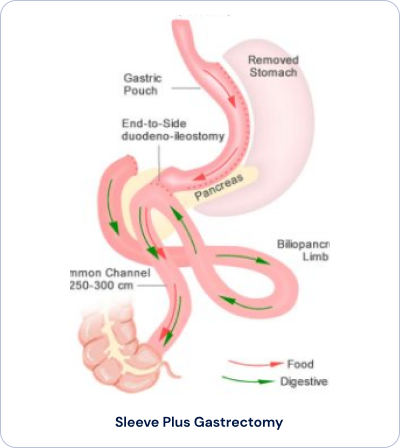- Anesthesia:
The patient will be put under general anesthesia to ensure that they are asleep and pain-free during the procedure. - Laparoscopic incisions:
he surgeon will make several small incisions in the abdomen and insert a laparoscope (a long, thin tube with a camera on
the end) to view the inside of the stomach. - Removal of a portion of the stomach:
Using surgical instruments, the surgeon will remove approximately 75-80% of the stomach, leaving a thin tube or “sleeve”
in place. - Stapling:
The remaining stomach is then stapled closed, creating a smaller stomach that is roughly the size of a banana. - Closing incisions:
The surgeon will close the incisions with sutures or surgical staples.
Sleeve Plus Gastrectomy surgery Benefits
Sleeve plus gastrectomy procedures, also known as hybrid or staged procedures, have several potential benefits for individuals who
are struggling with obesity and weight-related health conditions.
These benefits may include:
- Increased weight loss:
Sleeve plus procedures typically result in greater weight loss than single procedures, which may improve the chances of long-term weight loss success. - Improved metabolic outcomes:
Sleeve plus procedures have been shown to improve metabolic outcomes, including improvements in type 2 diabetes, high
blood pressure, and high cholesterol. - Reduced risk of complications:
By combining procedures, some risks associated with single procedures can be reduced or avoided altogether. For example,
the staged approach of SG-RYGB can reduce the risk of complications associated with a single RYGB procedure. - Improved quality of life:
Significant weight loss and improved metabolic outcomes can lead to an overall improvement in quality of life, including
improved mobility, increased energy levels, and improved self-esteem. - Potential cost savings:
In some cases, sleeve plus procedures may be more cost-effective than multiple single procedures, as they can reduce the
need for multiple hospital stays, anesthesia, and recovery periods.

Sleeve Plus Gastrectomy Procedures
Sleeve plus is a bariatric surgery that involves removing a portion of the stomach to reduce its size and decrease
hunger hormones. The procedure typically involves the following steps:

The sleeve gastrectomy surgery procedure typically takes around 1-2 hours to complete, and patients usually spend 1-2 days in
the hospital before being discharged.
Frequently asked questions
The amount of weight that a person loses after a laparoscopic sleeve gastrectomy (LSG) can lose between 50% and 70% of their excess weight
Laparoscopic sleeve gastrectomy (LSG) is a minimally invasive weight loss surgery that involves removing a portion of the stomach to create a smaller, sleeve-shaped stomach.
The recovery time after laparoscopic sleeve gastrectomy (LSG) can vary depending on the individual and the specific surgical techniques used, but most patients can expect to return to normal activities within 2-4 weeks after surgery.
Take charge of your health today. Schedule an appointment.
BOOK A SITTING
